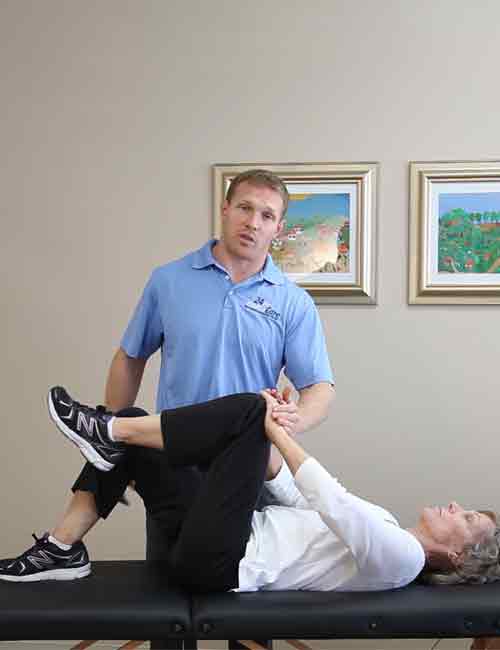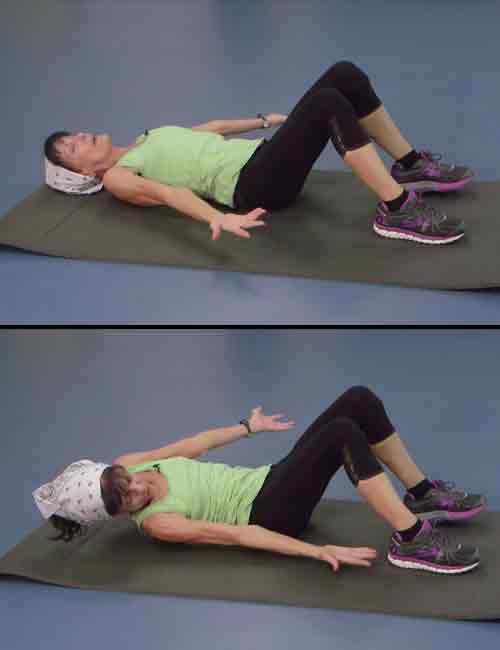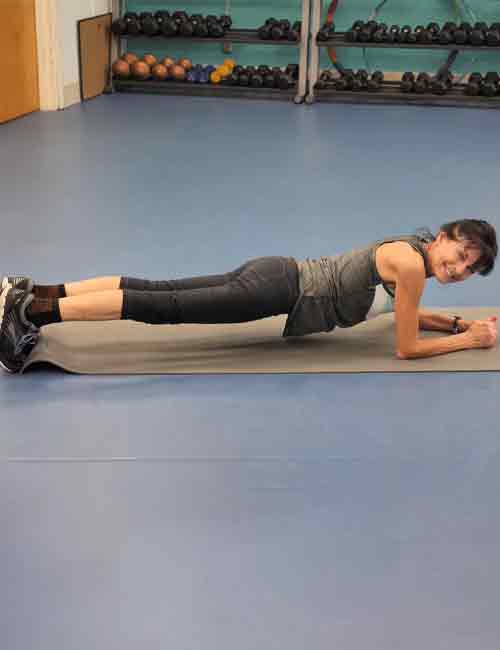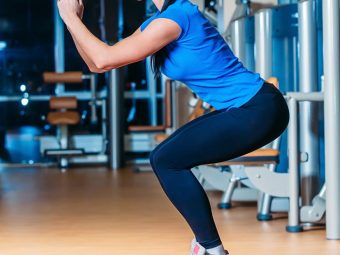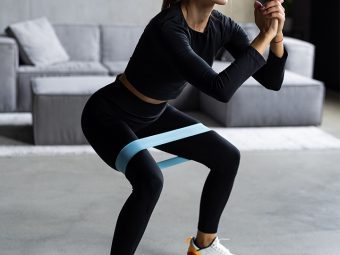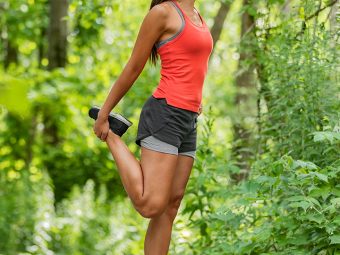12 Core Exercises For Seniors To Improve Their Stability
Strengthen your core by adopting some exercises appropriate for a well-built physique.
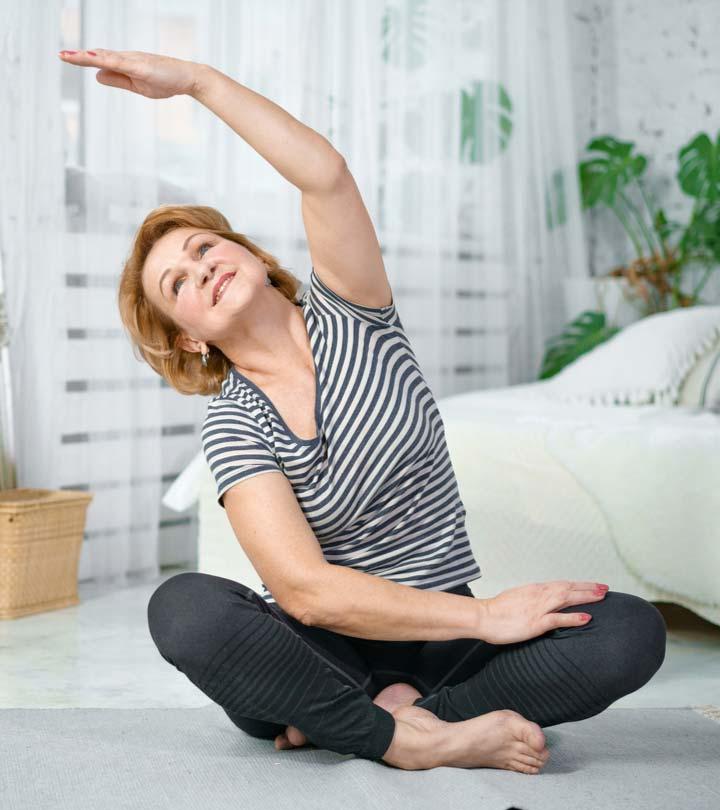
Image: Shutterstock
Try doing core exercises designed for seniors to stay fit. With age come several challenges like reduced bone strength and density and muscle weakness (1), (2). This, in turn, affects coordination, balance, and gait. You must focus on strengthening your core to regain muscle and bone strength, flexibility, mobility, balance, and fitness.
“A strong, functional core aids in the very basics like good breathing and posture. Good seated and standing posture keeps the center of mass where it needs to be, helping to prevent falls,” says Michael Julom (ACE-CPT, CFL1 Trainer). “Everyday activities people do late into life, such as getting out of bed and putting away the dishes, depend, at least in part, on core muscles,” he adds. Balance training, stretching exercises, strength training, stability exercises, bodyweight training, cardiovascular exercises, flexibility training, pilates, yoga for seniors, and functional movement training are all beneficial workouts that help in improving senior wellness.
To lead a good quality of life, read this post. Get yourself a therapy band, a good mat, and a stable chair to do these 12 best core strengthening exercises for adults over 50. Do them for 15-20 minutes a day. Scroll down!
In This Article
What Is ‘Core’?
We often use ‘core’ while referring to the ab or abdominal muscles. But, technically, the core muscles act as a boundary to the organs between the diaphragm and pelvic area. Michael Julom explains, “The core refers to the system of muscles that surround the midsection, both in front and in back. The core contributes to the structure and strength of the torso and helps protect the abdominal organs. It’s been referred to as the second spine.”
“Muscles of the core include the rectus abdominis (aka “the abs,” which make up the washboard appearance when they’re developed), the transverse abdominis, the internal and external obliques, the spinus erectors, and the multifidus and muscles deep inside the pelvis,” he says (3), (4).
Why is it so important to keep your core strong? Scroll down to find out.
Why Do I Need To Strengthen The Core?
Without a strong core, it would get difficult to perform day-to-day tasks like lifting objects, walking, standing up, etc. It could also lead to falls and cause one to depend on assistance to do regular tasks. In addition, osteoporosis, muscle loss, knee and back pain may make it worse. That is why it is best to do a few exercises every day to keep your core strong, improve joint health, and help in back pain prevention.
Below, you will find 12 low-impact exercises for the core designed for mature adults. Take a look at them and do them at home with or without assistance.
Note: Talk to your doctor before starting them and do a 10-minute warm-up.
12 Core Exercises For Seniors (With Pictures)
1. Marching In Place
How To Do
- Lie down on the mat or a flat surface.
- Flex your knees and place your feet flat on the floor. Keep your hands by your side or on top of the belly. Look at the ceiling. This is the starting position.
- Lift your right leg off the floor. Keep the knee flexed so that your lower leg and thigh are at 90 degrees to each other.
- Bring your knee right above your pelvis.
- Place your foot back on the mat.
- Do the same with the left foot.
- Do this 10-15 times.
2. March With Leg Extension
How To Do
- Lie down on the mat or a flat surface.
- Flex your knees and place your feet flat on the floor. Your hands should be by your side or on top of your belly. Look at the ceiling. This is the starting position.
- Lift your right leg off the floor and keep the knee flexed so that your lower leg and thigh are at 90 degrees to each other.
- Bring your knee right above your pelvis.
- Extend your leg in the front.
- Pause for a moment and bring your leg back to the flexed position.
- Place your foot back on the mat.
- Do the same with the left foot.
- Do this 10-15 times.
3. Isometric Core Strengthening
How To Do
- Lie down on the mat, with your knees flexed and feet flat on the floor.
- Keeping your knee flexed, lift your right leg off the floor.
- Bring your knee right above your pelvis.
- Place your palms on the right thigh.
- Push your palms and thigh against each other.
- Hold for 3 seconds and release.
- Put your foot down on the floor.
- Do the same with the left foot.
- Do this 10 times.
4. Resistance Band Leg Kicks
How To Do
- Grab a resistance band and tie a loop at one end.
- Hold the other end with your right hand, wrap the loop around your right leg, and get on all fours.
- Keep your elbows right below your shoulders, and the abs and glute tight.
- Lift your right leg off the floor and extend it back with your toes touching the floor. This is the starting position.
- Lift your right foot off the floor. Keeping it extended, lift it until your leg and spine are in the same line.
- Lower your foot.
- Just before it touches the floor, lift it again.
- Do this 10 times before switching legs.
5. Sitting Oblique Twists
How To Do
- Sit on a chair. Keep your spine straight, shoulders rolled back, and hands resting on your thighs. Look ahead.
- Bring your hands together in front of your chest, with the elbows out. This is the starting position.
- Looking ahead, turn your upper body to the right and then to the left.
- Do this 10-15 times.
6. Seated Side Bends
How To Do
- Sit on a chair. Keep your feet shoulder-width apart, hands open to the side, spine straight, and look ahead. This is the starting position.
- Bend to the right and try to touch the floor with your right hand.
- Come back up and bend to the left side.
- Do this 12 times.
7. Seated Forward Bends
How To Do
- Sit on a chair, with your feet wider than shoulder-width apart, spine straight, palms on the knees, and shoulders rolled back. Look straight ahead. This is the starting position.
- Hinging from the waist, bend forward and try to touch the floor with your hands.
- Hold the position for 5 seconds and come back up.
- Do this 10 times.
8. Bird Dog
How To Do
- Get on all fours on a mat. Engage your core and keep your spine, neck, and head in the same line.
- Lift your left leg off the floor and extend it behind you.
- Lift your right hand off the floor and extend it in front of you.
- Hold this position for 5-10 seconds.
- Get back to the starting position.
- Now, lift your right leg and extend it behind you.
- Lift your left hand off the floor and extend it in front of you.
- Hold this position for 5-10 seconds.
- Repeat this set 3 times.
 Quick Tip
Quick Tip9. Lying Ankle Taps
How To Do
- Lie down on a mat. Keep your knees flexed, and feet flat on the floor.
- Keep your hands by your side and lift your neck slightly off the floor.
- Bend to your right and try to touch the right ankle with your right hand.
- Come back to the starting position.
- Bend to the left and try to touch the left ankle with the left hand.
- Do this 12 times.
10. Plank
How To Do
- Get on all fours. Flex your elbows and place them on the floor.
- Extend your right leg behind with the toes on the floor.
- Extend your left leg behind.
- Support your body on your elbows and toes.
- Keep your core and glutes engaged.
- Keep breathing and hold this position for 10-30 seconds.
- Relax for 30 seconds and repeat two more times.
 Quick Tip
Quick Tip11. Leg Lifts
How To Do
- Lie on your back.
- Place your hands by the sides.
- Stretch to keep your legs straight and close.
- Slowly lift your legs.
- Keep raising your legs until they hover about 6-12 inches off the floor.
- Hold this position for 10 seconds.
- Repeat this leg lifting exercise 10-15 times.
12. The Bridge
How To Do
- Lie down on your back.
- Keep your knees bent and feet planted firmly on the floor.
- Lift your hips so that your body is a straight line from your shoulders to the knees.
- Squeeze your glutes and hold briefly.
- Then, slowly lower your hips.
- Repeat this bridge exercise 10-15 times.
These are the 12 core strengthening exercises that older adults can do to improve trunk stabilization and balance. However, ensure you do these posture correction exercises under expert supervision as the wrong posture may cause injuries. Also, keep in mind that aging can cause many other problems that can make exercising difficult, and sometimes, it is not advisable to do certain movements. A common problem is back pain. Read the next section to know if you can do core strengthening exercises with back pain.
Can I Do Core Exercises With Back Pain?
Yes. You can do seated, lying, or chair exercises with back pain. Avoid exercises like planks and leg back kicks unless you have a personal trainer around. You must also avoid lifting heavyweights.
Apart from protecting your back, there are some precautions to take while exercising to strengthen your core muscles. Here’s what to keep in mind.
Precautions To Take
• Avoid fast and jerky movements and exercises.
• Avoid lifting heavy objects.
• Practice good sitting and standing postures.
• Make sure the chair is stable and sturdy.
• Eat a balanced diet.
• Add protein to every meal.
• Consume nuts and seeds.
• Consume calcium-fortified foods.
• Talk to your doctor to know which supplements to take.
Infographic: Core Exercises For Seniors: Benefits And Tips
As you age, your core strength weakens, and it becomes difficult to even perform daily tasks. The only way to keep your core muscles strong and healthy is to exercise every day. The following infographic takes you through a list of benefits that you can reap by doing core exercises regularly and things you must keep in mind while doing them. Take a look! Illustration: StyleCraze Design Team
Save the high-quality PDF version on your device now.
Download Infographic
Core muscles, often referred to as the second spine, provide structural integrity and strength to the torso and protection to abdominal organs. Weakness in core muscles may increase the risk of falls, osteoporosis, and joint pain and make it challenging to perform day-to-day tasks. Core exercises for seniors such as marching in place, marching with leg extension, seated side bends, resistance band sidekicks, and lying ankle taps are all low impact exercises and should be done daily for 20-25 minutes. These exercises can greatly benefit your muscle tone and improve your posture, agility, flexibility, and gait without causing any harm or exacerbating any underlying conditions. If you have knee or back pain, the seated and lying exercises discussed here may be more suitable for you.
Frequently Asked Questions
Does walking strengthen your core?
Yes, it may strengthen the core muscles.
Does holding your stomach strengthen your core?
Yes. It may activate your core muscles and strengthen them. However, it may not give you a six-pack.
Can seniors with mobility issues still perform core exercises?
Seniors with mobility issues can perform core exercises with modified poses focusing on seated or supported exercises, depending on their ability.
How often should seniors incorporate core exercises into their routine?
Seniors should incorporate core exercises twice or thrice per week in their routine to maintain strength and stability.
Can seniors with osteoporosis or osteoarthritis safely perform core exercises?
Seniors with osteoporosis or osteoarthritis can safely perform core exercises. However, it’s better to perform exercise under the guidance of a healthcare professional or to customize their physical workout routine as per their capacity.
Can seniors with existing medical conditions or injuries still benefit from core exercises?
Seniors with existing medical conditions or injuries can benefit from modified core exercises tailored to their needs, and with the guidance of a trainer.
Can seniors incorporate core exercises into their regular fitness routine, such as walking or swimming?
Yes, seniors can incorporate core exercises, such as walking or swimming. It is only after focusing on their comfort and safety that they should perform all these core-focused exercises.
How long does it typically take to see results from incorporating core exercises into a senior’s routine?
Adding core exercises to a senior’s regimen can take time to show effects, but continuous practice can result in increased core strength and stability.
Key Takeaways
- Daily tasks, for instance, lifting objects, walking, standing up, and more, will be difficult if the core is not strong.
- Some core exercises for seniors include marching in place, marching with leg extension, isometric core strengthening, resistance band leg kicks, and sitting oblique twists.
- If you have back pain, you can do seated or lying exercises to strengthen the core. Avoid planks and leg back kicks, or do them only if supervised by a personal trainer. Do not lift heavyweights.
Discover the secrets to staying fit and healthy no matter your age! Check out this video to learn core exercises from a physical therapist to help you stay active even if you’re over 40.
References:
Articles on StyleCraze are backed by verified information from peer-reviewed and academic research papers, reputed organizations, research institutions, and medical associations to ensure accuracy and relevance. Read our editorial policy to learn more.
- Muscle weakness in the elderly: role of sarcopenia dynapenia and possibilities for rehabilitation
https://eurapa.biomedcentral.com/articles/10.1007/s11556-012-0102-8 - Aging and bone loss: new insights for the clinician
https://pubmed.ncbi.nlm.nih.gov/22870496/ - Core Stability Training for Injury Prevention
https://www.ncbi.nlm.nih.gov/labs/pmc/articles/PMC3806175/ - Core stability exercise principles
https://pubmed.ncbi.nlm.nih.gov/18296944/







